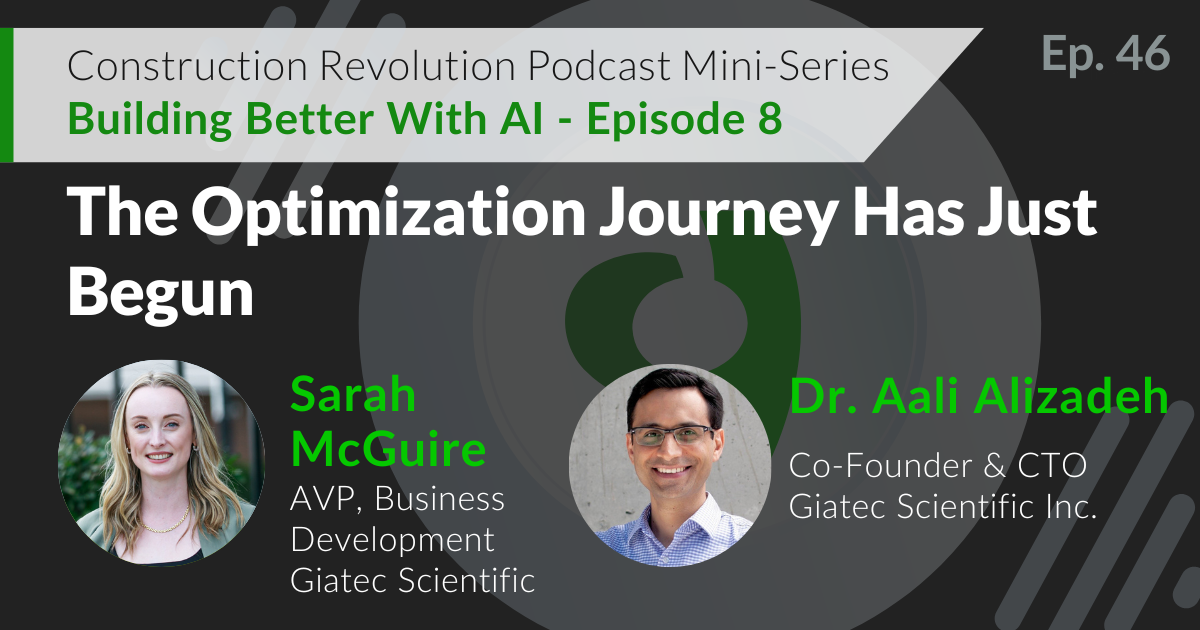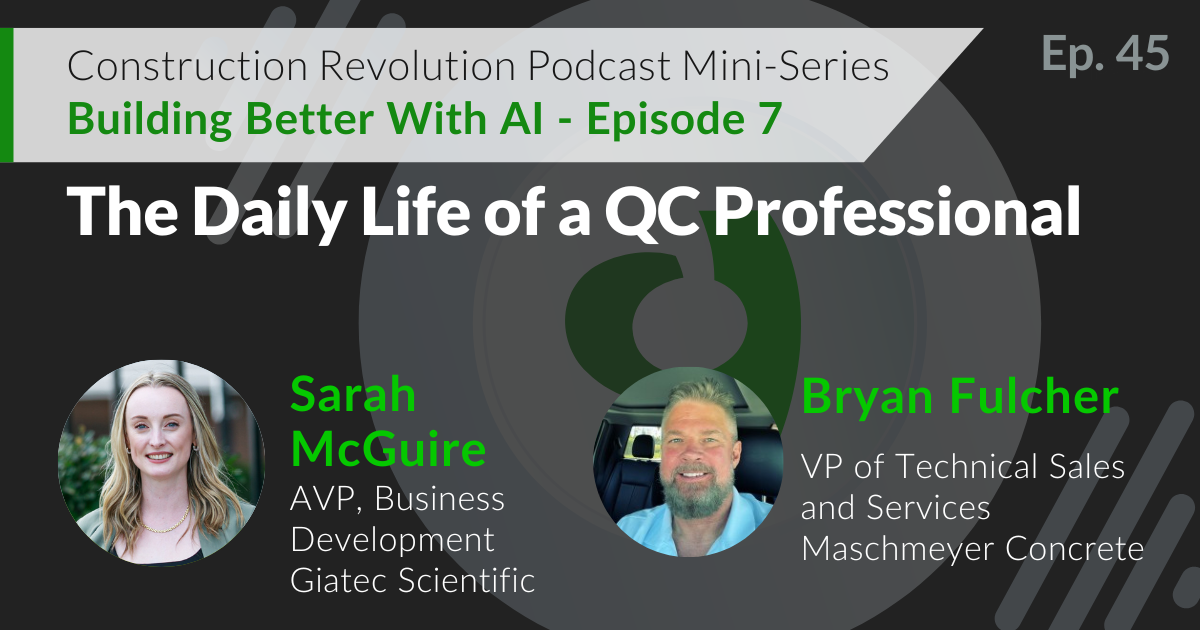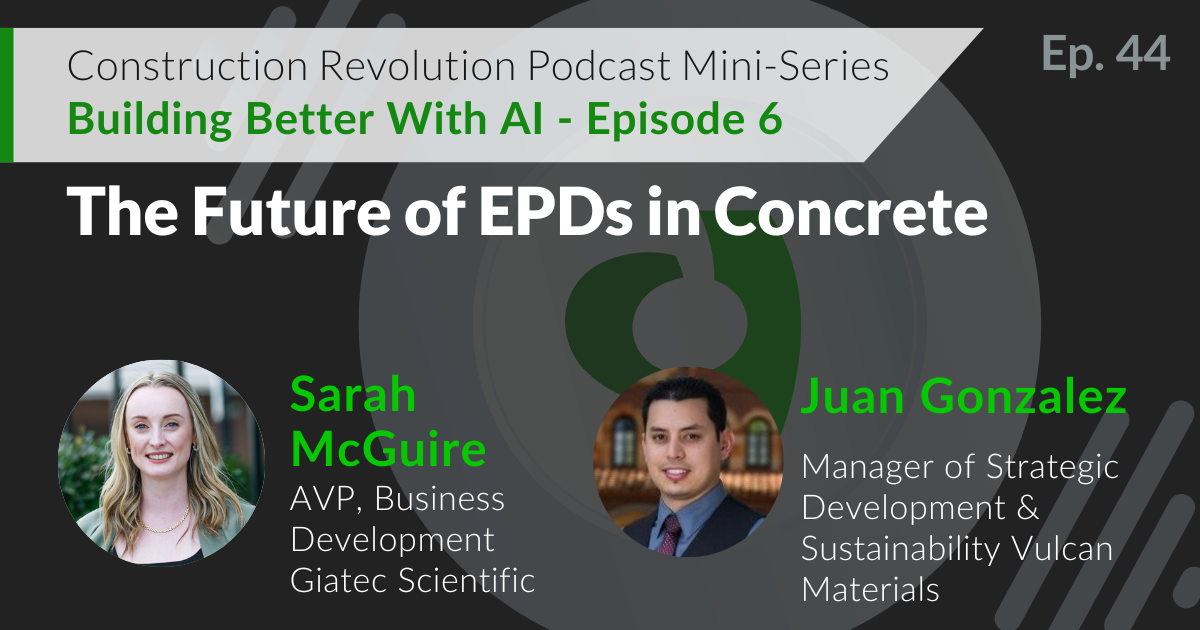
Episode 3 |
April 13, 2021
Revolutionizing the Concrete Industry
In This Episode
In this episode with Giatec Co-Founder and Chief Technical Officer, Dr. Aali Alizadeh, learn what motivated him and his business partner, Dr. Pouria Ghods, to start one of Ottawa’s Fastest-Growing Companies. Also hear about the latest technologies Giatec is developing and the company’s sustainability initiative through their artificial intelligence tool, SmartMix.

Host
ERIC YEE
Content Marketing Manager, Giatec Scientific Inc.
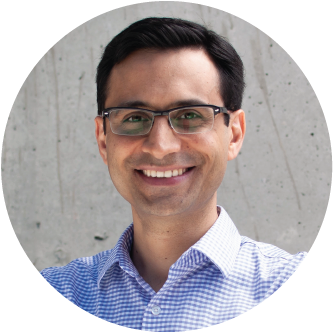
Guest
Dr. AALI ALIZADEH
Co-Founder & CTO, Giatec Scientific Inc
Podcast Transcript
Eric:
So Aali, I’d like to start off by going back 10 years prior to the start of Giatec, could you walk us through what you’re doing at the time and what caused you to start the company?
Aali:
Yeah, so it was an interesting time for us, both myself and my business partner, Dr. Pouria Ghods. We were doing our PhDs at that time. And we were so much deep into the research on the concrete side and corrosion of rebar in the concrete and together I think we had about almost a hundred joint papers published in this area. And when we finished our PhD studies, we realized that there’s a huge gap between what we were doing in academia and what was happening in industry.
Unfortunately, at that point, there was a bridge collapse that happened in Montreal, Canada, that killed two people. And it was so sad to see that we were doing so much research and we’re understanding the nature of concrete, and we can predict behavior at the research level, but in practice, these methods and solutions are not really applied. So, we decided to establish Giatec to bring some of those technologies to the market and build tools and solutions and easy to use devices that can be used by various stakeholders during the life cycle of concrete, with better assessment of concrete quality and prediction of its properties, so that they can make informed decisions, and hopefully we can prevent these kinds of incidents from happening.
Eric:
Do you find that there’s always a large chasm even today between academia and what’s going on in practical applications?
Aali:
There is a still a big gap. Yeah. So despite the fact that the industry has advanced a lot over the past 10 years, I would say, and it’s going through a transition, there is a digitization happening in the construction sector and concrete industry, but there is still a long way to go before we can see that the industry is driving the innovation and they are basically at the forefront of the change that we would like to see and the academic side.
It should be like that. The industry should generate those problems and pain points and bring it to the research level, whether it’s in-house research or academic research and the research people would find solutions for those pain points. Unfortunately, it’s not at that point yet. We see the academic world and the research world is far more advanced than what’s being applied in the field. But I’m hoping that within the new generation of engineers joining the workforce, and the fact that they’re demanding technology, we see more acceleration on the construction side, on the practice side that would basically adopt or generate new interest in the mimic world to design solutions for real world problems.
Eric:
Yeah, that would definitely be excellent. Especially if just getting a little closer between the two and bridging that chasm, I think it would be very beneficial to the whole industry. So, speaking of developing those kinds of solutions, when you first founded Giatec and enter the industry, what kind of challenges did you face?
Aali:
So, yeah, starting a company is difficult. There are so many challenges that you will face at the beginning. We definitely had to build a team, then that’s the starting point. You have to have the right people in the right places. The people who are passionate about the vision of the company, which for us was revolutionizing the concrete industry. So that was one of the main challenges to bring different people with different backgrounds and expertise, but with the same vision to work together in one small startup.
And because we were designing basically electronic devices and softwares, so we had to bring electronic engineers, concrete researchers, software developers, to develop the technology. And obviously we had to put in place a revenue engine, people from marketing sales and support to run that side of the business as well. So, building that team was one of the main challenges that we had at the beginning. And Giatec was bootstrapped from day one. So, we never raised money. And that also came with some of its own challenges. We had to do some consulting work on the side to generate some revenue and put that money in the R&D and development.
So, we had to run very lean and that forced us, actually in hindsight, to think more strategically about what we do and how we can gain maximum ROI in everything we would do, whether it was sales, marketing, product development, and it forced us to be very creative and different ways. And I would say that that actually worked out really well for us. So those were two of the main challenges, but like any other startup, we had to deal with many other business-related challenges.
On the construction side of things, the main challenge was, as I briefly mentioned, the gap that is still there, between what’s done in the academic world and the industry. The industry is very conservative and that’s understandable. The risks are very high when you want to adopt or implement new technology. For example, if you use a method in the design of a high rise, concrete structure that is not approved by regulators and it results in a collapse of some story that you will be liable for that.
So, construction in nature has become they’re conservative to follow regulations and standards and guidelines to prevent those liability issues. And so, we had to basically convince the industry that there’s a new technology for monitoring concrete properties, and how can you use it without having any standards for it and how you can benefit from it in that sort of ecosystem.
So that was one of the main challenges bringing new technologies to the market that is very heavily regulated. And I think we have done a good job in the sense that we made it so simple for the end users to adopt the technology, that it was a no brainer for them. And when they started out thinking technology, the regulators had to follow. Similar to Uber, so to speak that no, when they started to market, there was no regulation on the way that they were running their business.
There was a huge backlash from the taxi industry and regulators in the cities, but because the value was so much high for the end users and customers, including us, that we were using the app on a daily basis, the regulators had no choice but to adopt and basically pivot their regulations to allow for something like Uber. So, we think that the industry like construction, if they have to change, the technology has to be so simple and bring at least 10 times value to drive the adoption.
Eric:
Yeah. I can see where otherwise, if it didn’t bring that 10 times value, there’d be very little incentive for them to kind of change. Or so I think one thing that I’ve found very impressive since joining Giatec is all of the avenues in which we’ve made it so simple for them to embrace this, but also the education. The education that I couldn’t have been easy, I would say to try to educate people on these concepts and then have them to believe you, and then to buy into these products, like you said.
Aali:
Definitely.
Eric:
Giatec aside from just SmartRock, there’s a ton of innovative solutions that the company has produced. I would love to know more about how you identify the need for those solutions in the marketplace.
Aali:
Yeah. So obviously a SmartRock is our flagship product that is already using more than 7,000 projects worldwide. Back in the day, 10 years ago, when we started Giatec, we offered our first product for concrete permeability assessment. And that was called RCON, that would measure that the measured electrical resistivity of concrete, which is a parameter that you can correlate to other properties, including permeability, concrete cracking, and even concrete setting.
So that was purely based on research that we had previously done in academia. And we brought that product to life by building RCON. Then as we went out to the market and we offered this product to the market, we learned more about the other needs in the industry. So, as we were talking with customers whether there were testing labs, consulting engineers, inspectors, construction companies, and concrete producers, we wanted to learn more about the real pain points. And I briefly mentioned that there’s a gap between the industry and academia, and that gap also exists in the understanding of what’s actually the main pain points in the industry.
So, we learned new things that we didn’t really know in the past, from the academic world. So, we had to work with these stakeholders to understand their pain points more accurately and see what is on their mind, what keeps them awake at night, and so to speak and, and design solutions that would help them with those real pain points. And that’s how we develop Perma for chloride permeability. And as we got into the market, we’d realized that is that there is a huge need for that inspection, accurate inspection of bridges and parking garages for corrosion. And we got into the development of iCOR and XCell for corrosion monitoring. And in each of these products, normally we want it to develop a solution for the end users, but also, we wanted to bring a new angle to it, a technology that wasn’t using the past, a method that was innovative to add us that 10 times return for these stakeholders.
So, for example, in the case of iCOR, we developed it, the only corrosion device in the world, corrosion detection device in the world that would not need electrical connection to the rebar for measurements, unlike many other products that are in the market. So, with those changes, we wanted to make it so simple for the end users that at the end of the, when we release a product, that market, they would start using it, although there’s no regulation or standard or guideline for it from different organizations.
So that’s the portfolio of product, whether we were at the initial design stage or during the delivery of placement of concrete or after that, when concrete was in service, we decided to cover the whole range of needs in the industry from day one all the way through the life cycle of concrete, so that all the stakeholders can benefit from our solutions.
And the idea of the logic here was that if you bring value to all of the stakeholders at the end of the day, they collectively together would drive the adoption. If you bring value to one player here, the other players may not be open to adopting technology or benefiting from that technology. And to get the maximum value, you have to have an integrated solution that brings data throughout the life cycle of concrete and connects all of that together in one place. And that’s why we, in a way, developed technologies for all of these market segments within the concrete industry.
Eric:
I can see, too, where you have solutions now, between SmartMix at the beginning to SmartRock during and after pour, to all these post-construction solutions. Really do have a whole suite of products where especially when you’re starting out and you’re starting with just the, the NDT devices, I can see where that would build a ton of trust with people, which made it easier to launch SmartRock when you did. I think it was in 2015 or so, right?
Aali:
Yes. That’s a very good point. So, the fact that we had a portfolio of products that were designed and developed in the concrete industry, we’re offering already solutions and out of sync pain points in other parts of the market built that credibility so that when we release a SmartRock, we were not just a device manufacturer for that market. To them, we’re a solution provider building that basically pipeline of products during the life cycle of concrete. So that’s a very important point. And the other thing was that we wanted to educate the market. And so, our approach has been always as a knowledge-based company. We wanted to educate the industry, bring solutions, not only as a device manufacturer, but as a company that cares about the industry as a company that is there for our end users.
So, we go beyond our team, goes beyond what we are offering as a product. They are working very closely with our end users to design solutions for them and help them with the implementation of our products in their practice and how they can benefit from the data and analysis of data. We’re all the way working with them along alongside their team and their projects to gain maximum benefit from these products.
And then the other aspect that we brought to the business was leveraging the data. So, with these products already use in thousands of thousands of projects, you can imagine that we have collected millions of data points from concrete that’s being designed and cured in different conditions and ambient conditions worldwide. So, with that data, we built AI capabilities in our products to have smart suggestions in the solutions that we’re developing for our end users, so they can get maximum value, not only from the actual measurement, but from the analysis that comes after hand from AI capability, that is either in the sensor or the software that, for example, verifies the strengths calculation or predicts the performance of concrete.
These are things that end users just relying on their own data would have not been able to do, but collectively, because they are leveraging the pool of data from all the other users worldwide, we have been able to develop something like that for them that we really excited about.
Eric:
I want to touch on something that you just mentioned about you go above and beyond for support and working with end-users. I feel that yourself and Pouria are very uniquely situated, and it kind of goes back to something you mentioned earlier with, even though with your time at academia, when you’re getting into the space, there’s a lot of things you had to learn about the construction space that probably people that stay in academia don’t know. And launching into this you’ve really gotten on the construction industry, developing the solutions. I’m wondering since you started the company, how have you seen the construction industry change or evolve?
Aali:
So, yeah, there’s a lot of change that has happened over the past 10 years in the construction industry. Some of it is related to the technology advancement. So, electronics have become very, very cheap over the past 10 years. That has resulted in lowering the cost of sensors and equipment and tools. So that’s one big change. The costs of data has gone down significantly. The data access is now very easy everywhere in job sites, so that’s another advantage from technology perspective that has resulted in the adoption of technology over the past 10 years in the construction sector in particular… Not only construction, but also other things there. So, the cost of technology and availability of electronics is one consideration that we need to think about that has resolved in this change.
The other side is that the new generation of workforce that are joining the industry, young engineers, and practitioners, they are grown up with technology. They are raised with the smartphones and tablets and data and internet. And so, when they come to the workforce as a project manager, superintendent, or a ready-mix QC manager, they demand technology. That’s all they know, and there’s no other way for them to basically do their own their day-to-day job other than leveraging whether it’s software or other types of technologies.
So that has created a pool in the market. And with that, we see that there are tons of new startups, technology startups in the construction sector, mostly in the digitization of data. These are softwares for productivity in the construction sector, and also device manufacturers and tools and electronics and IOT and AI companies as well. So, they are responding to the need that is created in the market. Basically, these new engineers and workforce that are demanding technology and have that leverage, which is the cost of technology development has gone down significantly.
So, I think these two factors are driving the change and adoption, and we’re at a very, very interesting time. I think there is an acceleration that is happening in that side of the world by seeing new technologies used in the construction sector, not only today, but also in the next few years, I would say this acceleration will continue.
Eric:
So that actually dovetails quite well into my last question, before I let you go, Aali, is in the next 10 years, maybe 2032, do you have any predictions or guesses of what the industry might look like or what new technologies may be out there?
Aali:
Yeah. So, there are some of the technologies that are at their earliest stages. For example, the 3D printing of concrete is one of those technologies that its earliest stages. It will have some time until it gets wide adoption. But if it gets it up adopted and it becomes economical and safe to do, to build structures using 3D printing robots, and that’s a huge change in the way that we build structures. And especially in remote areas. you can imagine that you can have this 3D printing equipment deployed remotely in a village, somewhere in the middle of nowhere to build a structure. Whereas right now you need to have engineers, concrete suppliers, professional people who can build that structure. And that may not be possible everywhere in the world. So that’s one of the technologies that I think will get more involved over the next 10, 20 years.
Drones are also assessing some of the big needs and the inspection side of the world in the construction market. When you want to do inspection of a bridge or a high-rise you, if you want to monitor and track construction process during its earliest stages, when you’re building a structure, drones are playing a big role here to capture and document images and analyze that data. So that’s also one of the technologies. Especially, not only drones, but also robots in general, that are coming to the industry to automate some of the activities that were done previously by humans.
And the last maybe item is going to happen is data analytics, especially artificial intelligence. I think construction industry inherently contains massive amount of data. There are billions and billions of data points that are collected during the life cycle of a structure, whether it’s at the design stage or construction, or after that in-service, and historically this data wasn’t stored in one single place, it wasn’t integrated, there was no digitization and mass. So, we see that now with the softwares and technologies that are adopted, that digitalization is happening, that centralization of data is happening. So, we are getting easily access to a massive amount of data. So naturally the next step would be to leverage artificial intelligence and machine learning algorithms to go through this data and generate new insight that wasn’t possible in the past.
So, I think the next wave of technologies would rely on our artificial intelligence to mine the data and bring even more value than the actual digital technologies themselves to the end users. So those are the three things on the technology side that I can see. But also on the material side, there’s a huge opportunity to address the concrete material as a combination of different ingredients. So, you can think of concrete material as a recipe, and this recipe can be optimized to achieve the same previous performance that you expected from the concrete, but with less impact on the environment with more sustainable approach, that would result in less carbon dioxide emissions. So, I think with the new technologies that are assessing the carbon footprint of the concrete industry, by reducing the amount of cement that is used by improving its efficiency, we can see a big impact that is going to be achieved in the concrete industry by lowering its GHG emissions over the next 10 years, I would say.
Eric:
Definitely sounds like there’s a lot of exciting opportunities coming up in the construction space. I’m just picturing people-less construction sites with 3D printed buildings and robots and drones flying all around. Sounds pretty exciting. So Aali, I want to thank you again for coming on the show today. I know the listeners appreciate it. So once again, thank you.
Aali:
Thank you for having me, Eric.
Other Related Episodes
Episode 46 |
July 11, 2024
The Optimization Journey Has Just Begun
In the eighth and final episode of our "Building Better with AI" mini-series, "The Optimization Journey Has Just Begun," we’re introducing a unique twist. This time, Sarah McGuire, AVP Business Development, switches roles and steps into the hot seat to answer questions rather than ask them. To guide this special conversation, we’ve brought back our Co-Founder and CTO of Giatec, Aali Alizadeh, Ph.D. This episode provides a comprehensive update on where SmartMix, Giatec’s AI-powered mix management system, currently stands. Sarah and Aali discuss the significant progress made since recording the first episode in December 2023, highlighting the challenges overcome and valuable lessons learned during the implementation of SmartMix. Listeners will gain insight into customer success stories and the transformative impact SmartMix has had on the concrete industry. This episode offers a reflective and forward-looking perspective on the journey of SmartMix, showcasing how it continues to drive innovation and efficiency. Tune in for a compelling discussion that not only recaps our journey but also looks ahead to the future of AI in the concrete industry. Don’t miss this insightful and engaging conclusion to our mini-series!
PLAY
Episode 45 |
June 27, 2024
The Daily Life of a QC Professional
In the seventh episode of the "Building Better with AI" mini-series, host Sarah McGuire explores "The Daily Life of a QC Professional" with Bryan Fulcher, VP of Technical Sales and Services, Maschmeyer Concrete. Drawing on extensive industry expertise, Bryan provides a glimpse into the multifaceted role of quality control professionals in the concrete sector. The conversation begins with Bryan's career journey and the evolving expectations and challenges faced in QC over the past two decades. Throughout the episode, Sarah and Bryan delve into key topics such as misconceptions about QC, the integration of AI and technology in enhancing efficiency, and preparing for the future of AI-driven QC processes. Bryan shares practical insights into managing daily operations, handling technical challenges, and fostering industry-wide innovation. Tune in now to gain a deeper understanding of the pivotal role QC professionals play in shaping construction standards and driving quality assurance in the concrete industry!
PLAY
Episode 44 |
June 13, 2024
The Future of EPDs in Concrete
In the sixth episode of the "Building Better with AI" mini-series, host Sarah McGuire delves into “The Future of EPDs in Concrete” with featured guest Juan Gonzalez, Manager of Strategic Development & Sustainability, Vulcan Materials. With a wealth of experience, Juan shares valuable insights into his journey within the field of sustainable construction and environmental practices. The conversation begins with an exploration of the history and evolution of Environmental Product Declaration (EPD) reporting, highlighting Vulcan Materials' pioneering efforts as the first company to produce EPDs with Climate Earth. Throughout the discussion, Sarah and Juan address questions surrounding the role of EPDs in modern construction. Juan elaborates on the motivations behind Vulcan Materials' early adoption of EPD reporting, the challenges faced in championing this initiative, and the regulatory standards that have been influential in driving EPD adoption further. Tune in now to gain valuable insights that could reshape your perspective on EPD reporting and drive meaningful change in the industry!
PLAY
Want to Be a Guest Speaker, Sponsor, or Just Have a Question for Us? Fill In the Form!

